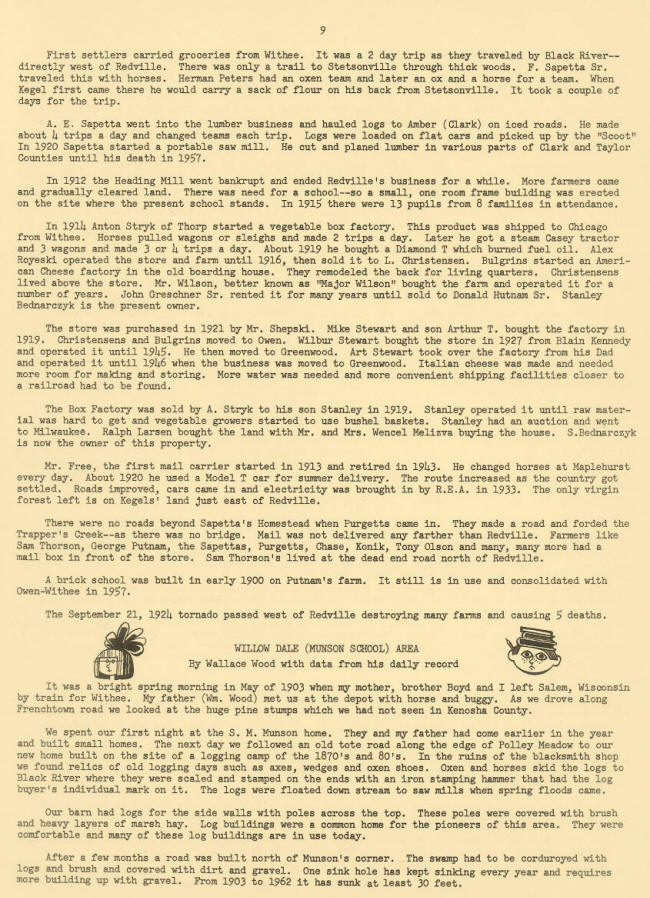|
[Memory
Trails Index]
Transcription
Janet Schwarze
First
settlers carried groceries from Withee. It was a 2 day trip as they
traveled by Black River-— directly west of Redville. There was only
a trail to Stetsonville through thick woods. F. Sapetta Sr. traveled
this with horses. Herman Peters had an oxen team and later an ox and
a horse for a team. When Kegel first came there he would carry
a sack of flour on his back from Stetsonville. It took a couple of
days for the trip.
A. E. Sapetta went into the lumber business and hauled logs to Amber (Clark) on
iced roads. He made about L trips a day and changed teams each trip. Logs were
loaded on flat cars and picked up by the “Scoot” In 1920 Sapetta started a
portable saw mill. He cut and planed lumber in various parts of Clark and Taylor
Counties until his death in 1957.
In 1912 the Heading Mill went bankrupt and ended Redville’s business for a
while. More farmers came and gradually cleared land. There was need for a
school--so a small, one room frame building was erected on the site where the
present school stands. In 1915 there were 13 pupils from 8 families in
attendance.
In l9l4. Anton Stryk of Thorp started a vegetable box factory. This product was
shipped to Chicago from Withee. Horses pulled wagons or sleighs and made 2 trips
a day. Later he got a steam Casey tractor and 3 wagons and made 3 or 1 trips a
day. About 1919 he bought a Diamond T which burned fuel oil. Alex Royeski
operated the store and farm until 1916, then sold it to L. Christensen.
Buigrins started an American Cheese factory in the old boarding house. They
remodeled the back for living quarters. Christensens lived above the store. Mr.
Wilson, better known as “Major WilsonT bought the farm and operated it for a
number of years. John Grescimer Sr. rented it for many years until sold to
Donald Hutnani Sr. Stanley Bednarczyk is the present owner.
The store was purchased in 1921 by Mr. Shepski. Mike Stewart and son Arthur T.
bought the factory in 1919. Christenseris and Buigrins moved to Owen. Wilbur
Stewart bought the store in 1927 from Blain Kennedy and operated it until 19L5.
He then moved to Greenwood. Art Stewart took over the factory from his Dad and
operated it until l9k6 when the business was moved to Greenwood. Italian cheese
was made and needed more room for making and storing. More water was needed and
more convenient shipping facilities closer to
a railroad had to be found.
The Box Factory was sold by A. Stryk to his son Stanley in 1919. Stanley
operated it until raw material was hard to get and vegetable growers started to
use bushel baskets. Stanley had an auction and went to Milwaukee. Ralph Larsen
bought the land with Mr. and Mrs. Wencel Melizva buying the house. S. Bednarczyk
is now the owner of this property.
Mr. Free, the first mail carrier started in 1913 and retired in l9l3. He changed
horses at Maplehurst every day. About 1920 he used a Model T car for summer
delivery. The route increased as the country got settled. Roads improved, cars
came in and electricity was brought in by R.E.A. in 1933. The only virgin forest
left is on Kegels’ land just east of Redville.
There were no roads beyond Sapetta’s Homestead when Purgetts came in. They made
a road and forded the Trapper’s Creek--as there was no bridge. Mail was not
delivered any farther than Redville. Farmers like Sam Thorson, George Putnam,
the Sapettas, Purgetts, Chase, Konik, Tony Olson and many, many more had a mail
box in front of the store. Sam Thorson’s lived at the dead end road north of
Redville.
A brick school was built in early 1900 on Putnam’s farm. It still is in use and
consolidated with Owen-Withee in 1957.
The September 21, l921. tornado passed west of Redville destroying many farms
and causing 5 deaths.
WILLOW DALE (MUNSON SCHOOL) AREA
By Wallace Wood with data from his daily record
It was a bright spring morning in May of 1903 when my mother, brother Boyd and I
left Salem, Wisconsin by train for Withee. My father (Wm. Wood) met us at the
depot with horse and buggy. As we drove along Frenchtown road we looked at the
huge pine stumps which we had not seen in Kenosha County.
We spent our first night at the S. M. Munson home. They and my father had come
earlier in the year and built small homes. The next day we followed an old tote
road along the edge of Polley Meadow to our new home built on the site of a
logging camp of the 1870’s and 80’s. In the ruins of the blacksmith shop we
found relics of old logging days such as axes, wedges and oxen shoes. Oxen and
horses skid the logs to Black River where they were scaled and stamped on the
ends with an iron stamping hammer that had the log buyer’s individual mark on
it. The logs were floated down stream to saw mills when spring floods came.
Our barn had logs for the side walls with poles across the top. These poles were
covered with brush and heavy layers of marsh hay. Log buildings were a common
home for the pioneers of this area. They were comfortable and many of these log
buildings are in use today.
After a few months a road was built north of Munson’s corner. The swamp had to
be corduroyed with logs and brush and covered with dirt and gravel. One sink
hole has kept sinking every year and requires more building up with gravel. From
1903 to 1962 it has sunk at least 30 feet.
[Next]
[Memory
Trails Index]
|
